Isla Española: Punta Suárez to Gardner Bay. Monday, 18 April, 2011.
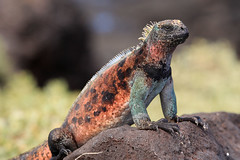 Overnight the boat sailed for Española Island, in the far south-eastern corner of the archipelago and the oldest of all the Galapagos Islands. We began our day with breakfast, which included fried eggs and small cake-like objects made of plantain, with a haloumi-like cheese inside them.
Overnight the boat sailed for Española Island, in the far south-eastern corner of the archipelago and the oldest of all the Galapagos Islands. We began our day with breakfast, which included fried eggs and small cake-like objects made of plantain, with a haloumi-like cheese inside them.
The first expedition of the day was an excursion to Punta Suarez, on the western end of the island. On the beach at the landing site here we saw many specimens of the distinctively bright coloured Española variety of the marine iguana, with large patches of bright red on their flanks. Again there were also plenty of blue-footed boobies and bright red crabs, though only a few sea lions. The day was again warm and muggy, with chaotic looking clouds that threatened either rain or bright sunshine at any time.
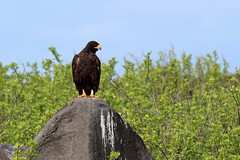 The first new bird we saw on our trek was a Galapagos hawk, sitting on a small rock outcrop poking out of the vegetation. It seemed completely unconcerned with us. We also saw brown pelicans, preening on rocks or flying around. And while watching from the beach we saw several boobies diving into the water to catch fish. They circled around about 10 metres above the water, spotting fish below with their keen eyes. Then suddenly one would break from horizontal flight and dive headlong straight into the water like a bullet, pulling its wings in at the last second before impact. The bird would surface a few seconds later, presumably with a fish in its beak.
The first new bird we saw on our trek was a Galapagos hawk, sitting on a small rock outcrop poking out of the vegetation. It seemed completely unconcerned with us. We also saw brown pelicans, preening on rocks or flying around. And while watching from the beach we saw several boobies diving into the water to catch fish. They circled around about 10 metres above the water, spotting fish below with their keen eyes. Then suddenly one would break from horizontal flight and dive headlong straight into the water like a bullet, pulling its wings in at the last second before impact. The bird would surface a few seconds later, presumably with a fish in its beak.
William had warned us this morning to take insect repellent, but there seemed little need for it yet. As we set out on a walk across the island, another tour group appeared at the end of the loop walk we were about to take. Their leader warned us to make sure we had plenty of insect repellent, as there were loads of mosquitoes on the walk. Undaunted, we set off, crossing the scrub-covered lava rock of the island, and were soon set on by clouds of the mosquitoes. Our repellent, being 80% DEET, was the most effective of any used by the people in our group. While some others were swatting mosquitoes and busily applying more repellent, we walked through unaffected.
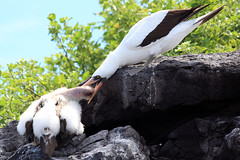 Across the point and on the other side of the island where the coast rose from the sea in cliffs up to around 10 metres high, there were lots of nesting birds, mostly Nazca boobies. William explained that the Nazca boobies took the prime nesting sites at the top of the sea cliffs and bullied the less aggressive blue-footed boobies into less desirable nesting locations further inland. We saw booby chicks and parents feeding them. The rocks around the nests were streaked white with guano.
Across the point and on the other side of the island where the coast rose from the sea in cliffs up to around 10 metres high, there were lots of nesting birds, mostly Nazca boobies. William explained that the Nazca boobies took the prime nesting sites at the top of the sea cliffs and bullied the less aggressive blue-footed boobies into less desirable nesting locations further inland. We saw booby chicks and parents feeding them. The rocks around the nests were streaked white with guano.
Near one booby nesting site was a marine iguana nesting site, a bare rocky area in which the iguanas scraped holes in the ground to lay their eggs. While we were watching, a fight broke out between two of the iguanas, apparently over ownership of a nesting hole. We watched this interesting animal behaviour, which was over in a few seconds, then kept our eyes peeled for more. We were rewarded by another brief scrap between iguanas. It seemed the more dominant one quickly asserted its authority and the challenger slunk away. While watching for the possibility of another fight, we were astonished to see a frigatebird suddenly swoop down from the sky, head first into an iguana hole, then emerge with strings of egg yolk dripping from its mouth. It briefly attacked the hole again, eating an egg, then took off into the sky. Everyone was amazed and exclaiming with shouts of, “Did you see that?!” and so on. William said it was the first time in 18 years of working as a guide in the Galapagos that he’d ever seen a frigatebird attack the eggs in an iguana nest. He said normally they would take small iguanas but not eggs.
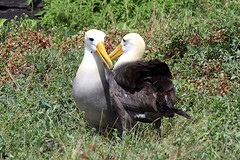 Stunned by this graphic demonstration of the savagery of nature, we continued on our walk around the island. We crossed a large flat area covered with low grass and other ground plants. Amidst this we came across two nesting pairs of waved albatrosses. These enormous birds were 10 metres or so away from the path that we had to keep on, so we couldn’t get as close as to other birds, but we could still appreciate their huge size and their nesting behaviour. The pairs of birds were obviously attached to one another, and danced around in courtship displays and groomed one another. Further along we saw some unpaired birds, including one resting under a bush very near the walking path.
Stunned by this graphic demonstration of the savagery of nature, we continued on our walk around the island. We crossed a large flat area covered with low grass and other ground plants. Amidst this we came across two nesting pairs of waved albatrosses. These enormous birds were 10 metres or so away from the path that we had to keep on, so we couldn’t get as close as to other birds, but we could still appreciate their huge size and their nesting behaviour. The pairs of birds were obviously attached to one another, and danced around in courtship displays and groomed one another. Further along we saw some unpaired birds, including one resting under a bush very near the walking path.
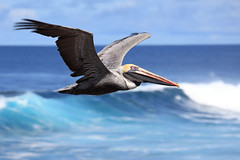 It was about this time that my shoes gave out. I’d brought a very old pair from home to wear while doing wilderness walks on this trip, planning to throw them out at some point before we packed our bags to return home. This was only the second day on the strip that I’d worn them, and the soles on both shoes now detached from the rest of the show, remaining held on only by a thin strip at the front. This caused them to flap about whenever I took a step. Things became even trickier when it started to rain, forcing ponchos on again, and making the lava rocks slippery. Leonie took a stumble on the rocks, but sustained only a scrape and was able to continue walking. We stepped more carefully from then.
It was about this time that my shoes gave out. I’d brought a very old pair from home to wear while doing wilderness walks on this trip, planning to throw them out at some point before we packed our bags to return home. This was only the second day on the strip that I’d worn them, and the soles on both shoes now detached from the rest of the show, remaining held on only by a thin strip at the front. This caused them to flap about whenever I took a step. Things became even trickier when it started to rain, forcing ponchos on again, and making the lava rocks slippery. Leonie took a stumble on the rocks, but sustained only a scrape and was able to continue walking. We stepped more carefully from then.
The rain eased off again, and we passed through much thicker clouds of mosquitoes. We applied more repellent just in case, but it seemed to be doing the trick because we weren’t bitten. Further along the path we came to a lookout spot over a large rock shelf, in which erosion had created a blowhole formation. We watched as several time the waves forced sea water up through the blowhole, forming a spout maybe 20 metres high. Around this area were lots of nesting Nazca boobies. William joked that sometimes a marine iguana would be caught in the blowhole and we might get to see the rare Galapagos flying iguana.
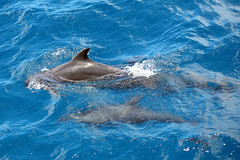 A bit further on we added the Hood mockingbird to our list of bird species spotted. The track back to the beach went through vegetation that was about chest high, and contained the thickest clouds of mosquitoes yet. They followed us back to the beach we landed near, and continued hovering around us there, though we hadn’t seen any near the beach when we’d arrived. The rain reappeared and I had to don a poncho to keep my camera gear dry. I was wondering how best to negotiate the dinghy trip back without getting wet, but fortunately the rain didn’t last long and by the time the second dinghy appeared to take us back as part of the second subgroup, I was able to remove the poncho and repack my camera into my backpack.
A bit further on we added the Hood mockingbird to our list of bird species spotted. The track back to the beach went through vegetation that was about chest high, and contained the thickest clouds of mosquitoes yet. They followed us back to the beach we landed near, and continued hovering around us there, though we hadn’t seen any near the beach when we’d arrived. The rain reappeared and I had to don a poncho to keep my camera gear dry. I was wondering how best to negotiate the dinghy trip back without getting wet, but fortunately the rain didn’t last long and by the time the second dinghy appeared to take us back as part of the second subgroup, I was able to remove the poncho and repack my camera into my backpack.
Over lunch the boat took a short cruise across Española to Gardner Bay. During the cruise, bottlenose dolphins accompanied the boat, playing and leaping in the water off the ship’s bow. We got a good close look at them. There were also frigatebirds in the sky trailing the boat as well.
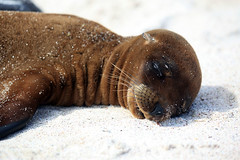 At Gardner Bay the main activity was snorkelling, though there was also the chance for non-snorkellers to sit or walk around the beach there. M. elected to stay on the boat resting and reading her book, which turned out to be a wise decision as the beach was rife with mosquitoes and it would have been a miserable time staying there while others went snorkelling in the waters off a series of rocks in the lagoon. This snorkelling expedition was better than the first one, with lots of other fish and sea life; I spotted creatures including a tiger snake eel, pencil urchins, a ray of some sort, and lots of sea lions. The sea lions here were very playful, swimming about in the water with us. Several times one would come close enough to me to reach out and touch, though I resisted the urge to do so. Towards the end of our snorkelling session, Anne popped up out of the water and said that she’d just seen a white-tipped reef shark, about a metre long. I and several other people quickly swam over to try to see it, but it had vanished.
At Gardner Bay the main activity was snorkelling, though there was also the chance for non-snorkellers to sit or walk around the beach there. M. elected to stay on the boat resting and reading her book, which turned out to be a wise decision as the beach was rife with mosquitoes and it would have been a miserable time staying there while others went snorkelling in the waters off a series of rocks in the lagoon. This snorkelling expedition was better than the first one, with lots of other fish and sea life; I spotted creatures including a tiger snake eel, pencil urchins, a ray of some sort, and lots of sea lions. The sea lions here were very playful, swimming about in the water with us. Several times one would come close enough to me to reach out and touch, though I resisted the urge to do so. Towards the end of our snorkelling session, Anne popped up out of the water and said that she’d just seen a white-tipped reef shark, about a metre long. I and several other people quickly swam over to try to see it, but it had vanished.
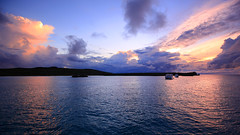 The dinghies picked up some of the snorkellers, but a few of us chose to swim all the way back to the beach ourselves. This was about 200 metres across the lagoon. As we approached the beach the water became cloudy with the fine white coral sand, so there wasn’t much to see there. On the beach, there were lots of sea lions. A small lagoon filled by water washing over a sandbar was about 10 metres in diameter and waist deep with water heated by the sun. In this pool were playing dozens of baby sea lions. We could wade right in amongst them all. Amazingly, the mother sea lions, who were around watching their babies, didn’t show any aggressive protective tendency at all. They seemed to not care at all about the presence of humans. The only real danger here was the mosquitoes, which we were glad to evade when the dinghies took us off the beach and back to our boat.
The dinghies picked up some of the snorkellers, but a few of us chose to swim all the way back to the beach ourselves. This was about 200 metres across the lagoon. As we approached the beach the water became cloudy with the fine white coral sand, so there wasn’t much to see there. On the beach, there were lots of sea lions. A small lagoon filled by water washing over a sandbar was about 10 metres in diameter and waist deep with water heated by the sun. In this pool were playing dozens of baby sea lions. We could wade right in amongst them all. Amazingly, the mother sea lions, who were around watching their babies, didn’t show any aggressive protective tendency at all. They seemed to not care at all about the presence of humans. The only real danger here was the mosquitoes, which we were glad to evade when the dinghies took us off the beach and back to our boat.
We were greeted with mini pizzas for snacks, essentially grilled tomato and cheese on bread, plus freshly made passionfruit juice which was sweet and delicious. M. liked it so much she grabbed a second glass. The we had resting time before dinner. Tonight it was ham steaks and a sweet and sour seafood dish made with what appeared to be the same processed seafood as in fish balls. The sunset was nice, but not as good as yesterday. The full moon rose above the glistening sea as darkness fell, spreading silvery ripples across the water, giving us a beautiful last night here in the Galapagos islands.
